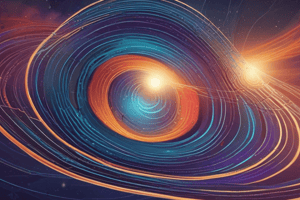Podcast
Questions and Answers
Flashcards are hidden until you start studying
Study Notes
Energy Forms and Transformations
- Energy is neither created nor destroyed, only transformed from one type to another
- Types of energy: gravitational potential energy, kinetic energy, radiant energy, chemical energy, electrical energy, nuclear energy
Gravitational Potential Energy
- Depends on an object's height
- Calculated by the equation: GPE = mgh (mass x acceleration due to gravity x height)
Kinetic Energy
- Depends on an object's movement
- Calculated by the equation: KE = 1/2 mv^2 (one half x mass x velocity squared)
Radiant Energy
- Can travel through empty space (vacuum)
- Comes in the form of electromagnetic radiation and gravitational radiation
- Examples: sunlight, gamma rays, radio waves
- Travel at the speed of light (~300,000,000 m/s in a vacuum)
Chemical Energy
- Stored in the bonds of chemical compounds
- Released or absorbed through chemical reactions
- Examples: photosynthesis, batteries, hand warmers, petroleum
Electrical Energy
- Caused by moving electric charges
- Measured in Joules
- Can be kinetic or potential energy
- Examples: moving electrons in a wire, lightning, batteries
Nuclear Energy
- Released from the nucleus of atoms
- Through fission (splitting atoms) or fusion (combining atoms)
- Examples: nuclear power plants, stars like the Sun
Heat Capacity
- The minimum heat absorbed by a substance before a unit change in temperature
- Specific heat capacity: for one gram of a substance
- Molar heat capacity: for one mole of a substance
- Examples: water has a high specific heat, metals have low heat capacity
Energy in Living Organisms
- Energy is required for survival and reproduction
- Energy from the sun is transformed into usable forms for living organisms
- Examples: photosynthesis, cellular respiration, ATP
Vibrations and Waves
- Repeated back-and-forth motion of a particle
- Characterized by periodic motion
- Examples: sound waves, light waves, ocean waves
Sound Waves
- Vibrations that travel through a medium (solid, liquid, gas)
- Speed of sound depends on the medium
- Frequency, wavelength, amplitude, period, and speed are related
- Examples: music, voice, echoes
Electromagnetic Spectrum
- Range of frequencies of electromagnetic radiation
- Includes: radio waves, microwaves, infrared light, visible light, ultraviolet light, X-rays, gamma rays
- Each type has a specific frequency and wavelength
Color and Light
- Electromagnetic radiation with a frequency visible to the human eye
- Visible spectrum: red, orange, yellow, green, blue, indigo, violet
- Each color has a specific frequency and wavelength
Reflection of Waves
- Change in direction of waves when striking a surface
- Incident ray, reflected ray, and normal line are related
- Law of Reflection: angle of incidence equals angle of reflection
Interaction of Light with Objects
- Opacity: blocking of light
- Transparency: transmission of light
- Translucency: partial transmission and bending of light
- Examples: mirrors, glass, frosted glass
Refraction
- Bending of waves when passing from one medium to another
- Snell's Law: ratio of angles of incidence and refraction equal to ratio of indices of refraction
- Examples: prisms, lenses, total internal reflection### Doppler Effect
- When an ambulance siren is moving towards an observer, the observer perceives a higher pitch sound, and a lower pitch when it is moving away.
- A sonic boom occurs when a sound source is traveling faster than the speed of sound, an extreme form of the Doppler effect.
- Edwin Hubble used the Doppler effect in light emitted by distant galaxies to conclude that the universe is expanding.
- An observer will perceive a blue shifted galaxy when it is moving towards them, and a red shifted galaxy when it is moving away.
Properties of Light
- Properties of light include intensity (or brightness), direction, frequency (or color), and polarization.
- Light travels in straight lines, bounces symmetrically from mirrors, and can be colored (like a laser).
- White light contains a full rainbow inside it.
Reflection and Refraction
- Reflection is when light bounces off a shiny, reflective surface.
- Refraction is when light bends when moving from one medium to another.
- The law of reflection states that the incident angle is equal to the reflected angle.
- Refraction occurs due to density changes, causing a gradual bend in light.
Diffraction
- Diffraction is the process by which a beam of light is spread out as it passes through an aperture or across the edge of an object.
- Overlapping light waves create an interference pattern with light and dark areas.
- Constructive interference occurs when peaks or troughs of two waves meet, resulting in a light area.
- Destructive interference occurs when the peak of one wave meets the trough of another, resulting in a dark area.
- A single slit produces a diffraction pattern with a large central maximum and alternating bands of dark and light.
- Thinner apertures lead to more diffraction, with the pattern getting dimmer towards the edges.
Electric Power
- Electric power represents the ability of an electric source to supply or of an electric device to consume electric energy over a specific time period.
- Electric power is measured in watts (W), with 1 W equal to 1 joule per second.
- Electric devices and appliances have a label showing their electric power.
- Electric power can be calculated by multiplying current by voltage, or by multiplying current by resistance, or by dividing work done by time.
Electric Circuits
- An electric circuit is a complete loop in which electrons from a voltage or current source flow.
- The current in the circuit is the rate of flow of charge, measured in amps.
- Components in a circuit, such as bulbs, sensors, and motors, act as resistors, resisting the flow of charge.
- Resistance is voltage divided by current, so adding resistors decreases the current.
Voltage Sources
- Voltage sources provide energy to electrons in an electric circuit.
- Batteries are a type of voltage source that convert chemical energy into electrical energy.
- Generators use moving magnets and electromagnetic induction to generate voltage.
- Different types of voltage sources, such as nuclear, coal, natural gas, hydroelectric, and wind power, all convert energy into electric energy.
Studying That Suits You
Use AI to generate personalized quizzes and flashcards to suit your learning preferences.




